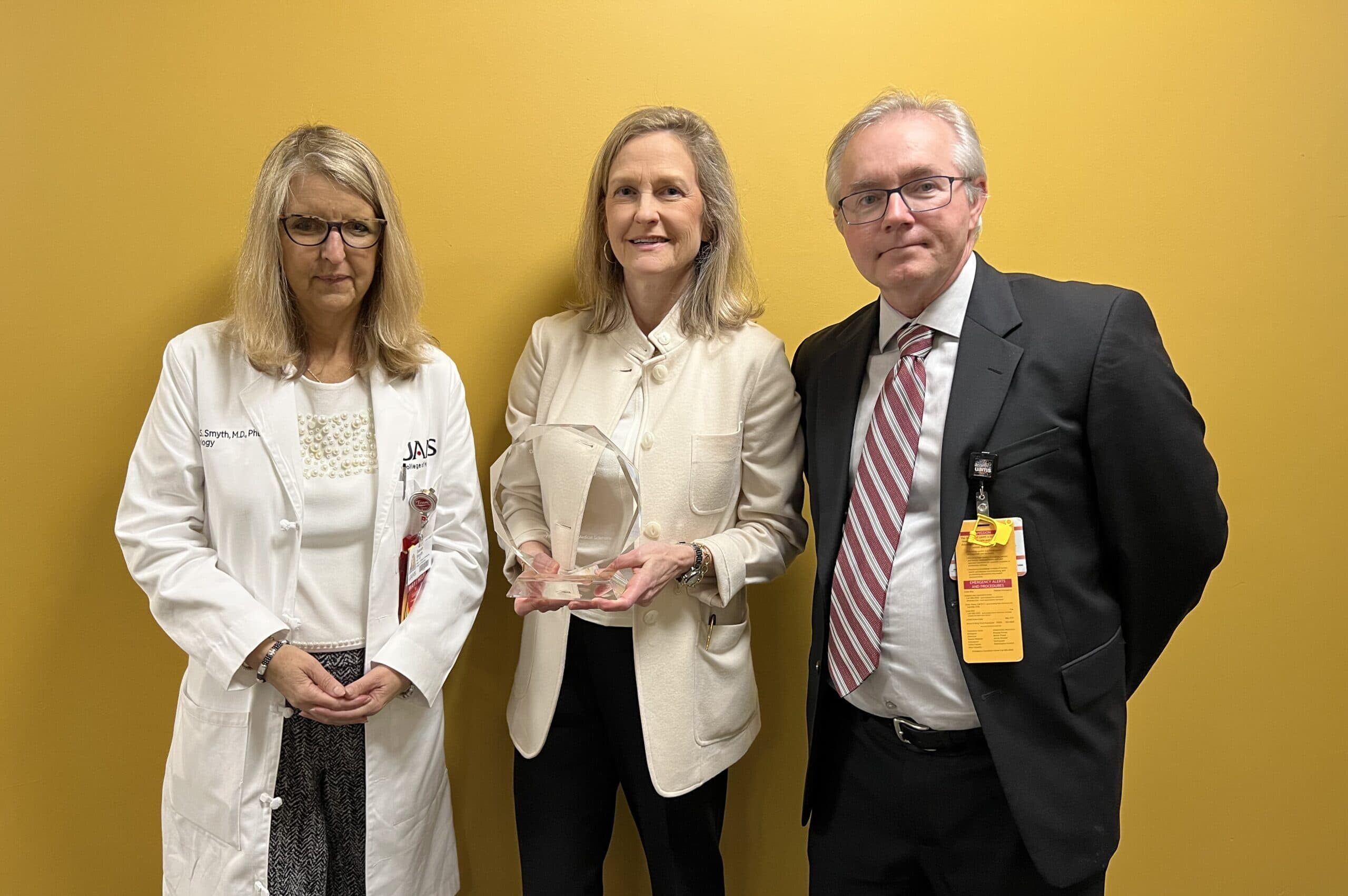UAMS College of Medicine Honors Stacie M. Jones, M.D., as Distinguished Faculty Scholar
| The College of Medicine at the University of Arkansas for Medical Sciences (UAMS) honored Stacie M. Jones, M.D., as the 2022 Distinguished Faculty Scholar for her groundbreaking research into food allergies, her leading role in the development of the first FDA-approved oral immunotherapy drug for life-threatening peanut allergy in children, and her dedication to mentorship.

Susan Smyth, M.D., Ph.D., executive vice chancellor of UAMS and dean of the College of Medicine, presents the college’s 2022 Distinguished Faculty Scholar award to Stacie M. Jones, M.D.
Jones, a professor in the Department of Pediatrics, delivered the annual Faculty Scholar Lecture Dec. 8 in an auditorium filled with research team members, other faculty from the Department of Pediatrics and Division of Pediatric Allergy and Immunology, and colleagues from throughout the college and Arkansas Children’s. Jones has served in the division since 1994 and was division director in 2003-2019.
“I want to recognize you for all of the things you have done in your field and for UAMS and Arkansas Children’s, and for mentoring so many people here in the audience and across the college,” said Susan Smyth, M.D., Ph.D., executive vice chancellor of UAMS and dean of the college. “You truly have had a distinguished career, and we are so pleased that you are part of our college and cannot wait to see where you and your team are going next in your work.”

Stacie M. Jones, M.D., briefs UAMS and Arkansas Children’s faculty, trainees and others on major advances in treatments for children with life-threatening peanut allergy that have been developed over the past 25 years during her Distinguished Faculty Scholar lecture.
“This is an incredible honor, and I stand before you in awe of all of our team that is here,” Jones said as she began her talk, which emphasized the power and positive impact of mentorship as part of the process of scientific discovery. “I am the best example I know of someone who has benefited from a breadth and depth of mentoring throughout my career.”
Jones’ 25-plus year career in pediatric allergy and immunology and food allergy research has paralleled the development of oral immunotherapy (OIT) for peanut allergy, leading to FDA approval in January 2020 of Palforzia, the first drug designed to mitigate severe allergic reactions, including anaphylaxis, that can occur in some individuals with accidental exposure to peanut. Anaphylaxis can involve swelling of the lips, tongue or throat, shortness of breath, trouble breathing and other potentially life-threatening symptoms.
OIT is an allergen-based treatment, meaning the substance, such as peanut, is carefully introduced in very small and incremental doses to the patient. Early development of OIT involved peanut powder ingested in a food “vehicle” such as applesauce, a strategy that continues currently. In addition to oral therapy, researchers in recent years have been exploring epicutaneous immunotherapy, which introduces the allergen via a patch placed on the skin, and sublingual therapy, which involves drops placed under the tongue. Researchers also are exploring potential non-allergen-based therapies, such as targeted biologics, the use of existing drugs originally designed for other purposes.

Pediatric Allergy and Immunology colleagues, food allergy research team members and others celebrate with Stacie M. Jones, M.D., (bottom right) after her Distinguished Faculty Scholar lecture.
Jones traced the work of her team, including longtime collaborators Amy Scurlock, M.D., a professor in the Division of Pediatric Allergy and Immunology at UAMS, and Wesley Burks, M.D., a former UAMS faculty member who went on to serve at Duke University and is currently dean of the University of North Carolina (UNC) School of Medicine, UNC vice chancellor for medical affairs and CEO of UNC Health. Jones and colleagues have focused much of their work in oral immunotherapy, with the primary goal of providing protection from severe allergic reaction from exposure to peanuts while patients are taking the therapy, achieving “desensitization.” The ultimate goal would be to help patients gain “tolerance” to peanuts knowingly included in their diet, even long after therapy has ended.
Jones said researchers have found strong evidence for protection against anaphylaxis, particularly with oral immunotherapy. For safety, compliance and ease of use, the epicutaneous and sublingual therapies have shown great promise. Significantly, recent research led by Jones and Burks has indicated a “window of opportunity” for treating children at a very young age and inducing “remission” from peanut allergy that could potentially allow them to introduce peanuts into their diet.
“We have a lot of work to do yet to understand the factors that impact these outcomes, to understand biomarkers that can help us personalize treatment, and certainly to move forward with opportunities like our birth-cohort study that may provide new intervention and prevention targets,” Jones said. “For us and for our patients, we believe that the future is very bright and that this work is very important.”
